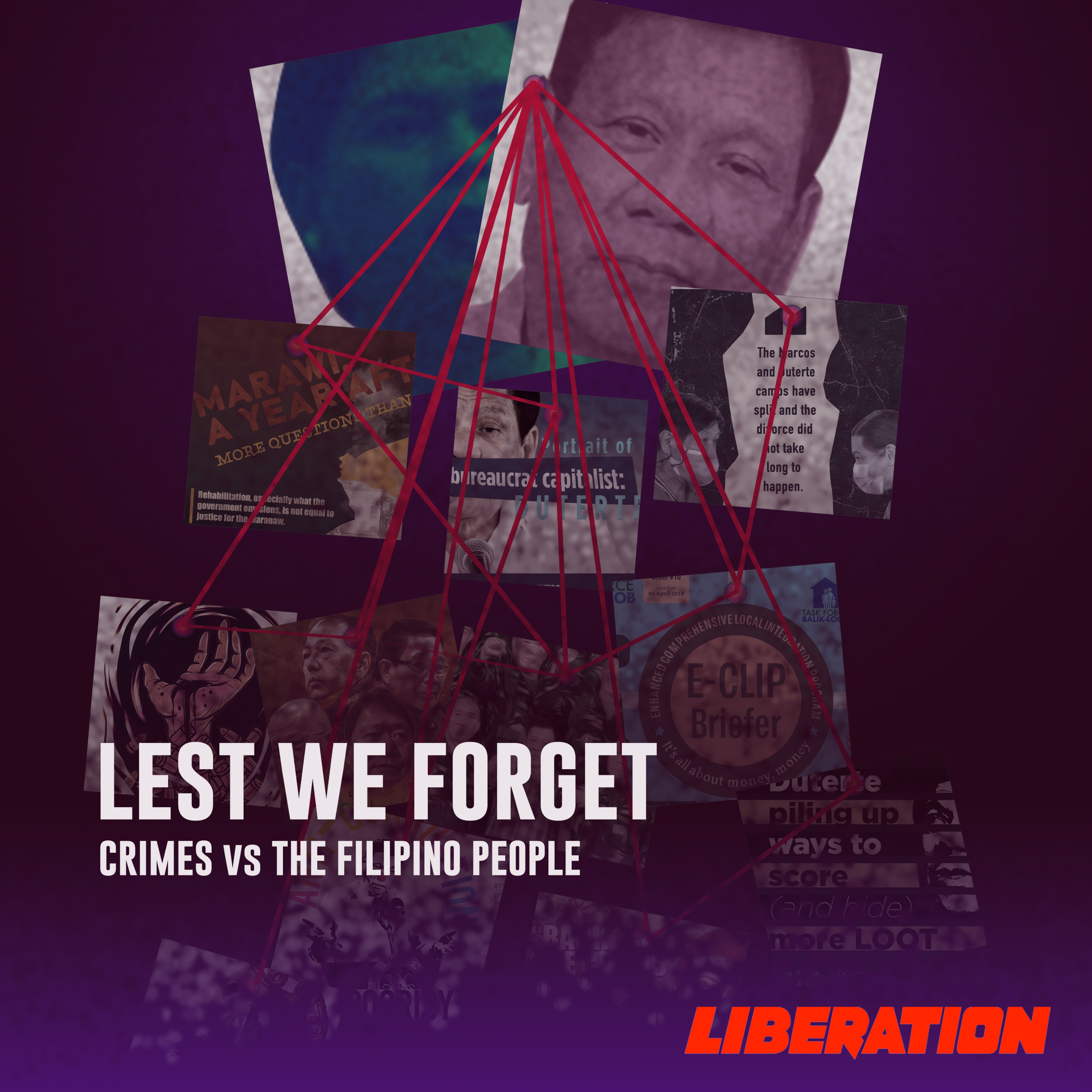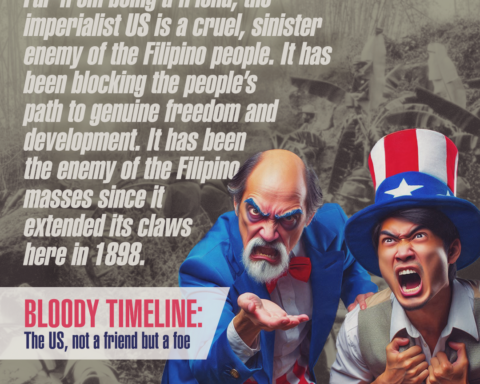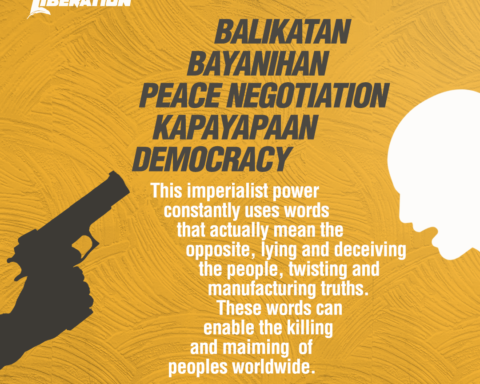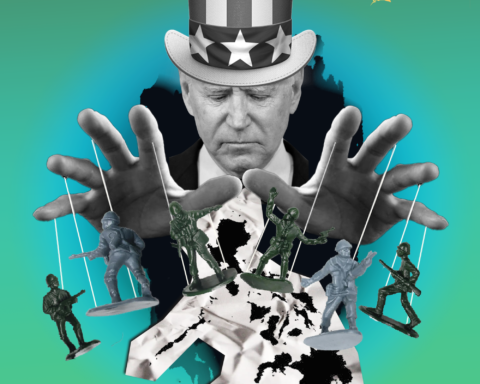“This is the Chinese Coast guard. This is under the jurisdiction of the Chinese government,” blared a Chinese officer who tried to bar a cargo ship from sailing through Panatag/Scarborough Shoal, a part of the Philippine territory off Zambales province in the South China Sea. His action has sparked an outcry, but as of this writing, the Duterte administration continues to avoid offending China.
Its officials—from Malacañang to the Foreign Secretary to the Philippine Coast Guard— have all refused to call out China’s infraction on Philippine sovereignty and on freedom of navigation. Meanwhile, at a Senate hearing around the same period, Defense Secretary Delfin Lorenzana stirred patriotic outrage when he downplayed the Chinese ships’ firing of flares as Philippine ships navigated the West Philippine Sea.
These are just two incidents in a series of cases of Chinese incursions into Philippine territory, all unchallenged, being dismissed, and at times even justified by the Duterte regime. Why would a tough-talking and cursing president, who advertises his stance as “charting an independent foreign policy,” court the people’s ire with blatant subservience? Perhaps, this question should begin with “How much…?”
An imperialist puppet’s gamble for bureaucratic loot
The first time President Rodrigo Duterte visited China three years ago, the Communist Party of the Philippines (CPP) already enumerated ways in which the Filipino people may benefit from ties with China. This would start ONLY IF Duterte strives to build diplomatic relations with China on the basis of equality, mutual respect, and mutual benefits, the CPP said at the time.
But Duterte did not listen. Instead he has shown that he is not at all capable of building diplomatic relations with China on the basis of equality, mutual respect, and mutual benefits. He has persistently desisted from asserting the country’s victory at the Permanent Court of Arbitration in The Hague, claiming China would wage war against the Philippines if he did so (which has no basis in fact). Thus, he has let pass China’s repeated incursions into our country’s extended economic zones (under the United Nations’ Convention on the Law of the Sea or UNCLOS) and bully Filipino fishers at Panatag Shoal.
Probably believing that in the prevailing system, presidents like him couldn’t be anything other than the worst imperialist puppets and bureaucrat capitalists of the day, Duterte is angling for whatever gains he could get from deals with the imperialists. His administration calls China an “integral partner” in their P4.23-trillion infrastructure buildup.
By now it is clear the only change that has come with Duterte is that besides serving US imperialist interests (while feigning to be distancing from it), his administration is moonlighting with another imperialist power, letting it latch on to wherever it can partake of the country’s riches and potentials.
The country’s foremost bureaucrat capitalist finds in China a promising huge pot of bureaucratic loot as former sources have dried up due to the economic slowdown, or are compelled by their citizens to raise questions on and denounce continuing extrajudicial killings and other human rights violations under his increasingly tyrannical rule. On this issue the Duterte administration is allergic to what he deems as foreign intervention.
“Duterte is in a hurry and desperate to secure his kickbacks from foreign loans and contracts from China,” the CPP said in a statement when Duterte still had three years in power. Duterte’s list of projects, flagship or otherwise, has since continued to evolve or get revised.
After three years in power, only nine of Duterte’s 75 listed “Build, Build, Build” projects begun construction. By November 2019, Duterte dropped the projects considered too long or unfeasible. It ‘overhauled’ the list such that only 30-plus of the original projects remained, and added another 68 to the “evolving” list. Half or 50 of Duterte’s flagship infrastructure projects will be funded by Overseas Development Assistance (ODA) or foreign loans, 23 are to be fully funded by the Philippine government, 24 by public-private funding, and only two will be privately financed.
Duterte’s panic over delayed delivery of the loot is palpable. Past midway in his six-year term, the amount supplied so far by China in loans and grants is still far short of the US$9 billion promised by President Xi Jinping during their first meeting in October 2016. Having already signed numerous deals with the Chinese government, his administration wants to proceed with implementing the projects ASAP so the funds could start pouring in. That can happen, of course, only if his administration can overcome the public criticisms and protests over the lopsided provisions of the deals that have been made public, criticisms for the lack of transparency on deals that have yet to be disclosed, and delays in completing the technical and legal requirements that include feasibility studies, environmental clearances, and the freely given consent of communities that would be adversely affected.
A sample of what the Duterte administration can do to push its deals with China: in time for the visit of Chinese vice-premier Hu Chunhua in October 2019, it railroaded the release of environmental compliance certificate and threatened to use police power against public protests on the Kaliwa Dam project in Sierra Madre. Yet, the protests were such that as of February 2020, his economic manager confirmed they have barely started construction in Kaliwa.
Protests against the China-funded projects hinder its implementation. Past debacles with China-funded projects such as the ZTE and Northrail also cast its shadow, slowing down Duterte’s hope for inflows of ODA from China. Until December 2019, the Chinese government wanted meetings with the Duterte government “to thresh out issues involving the Duterte regime’s big-ticket infrastructure and development projects that are being implemented with funding support from China.”
To push through with the projects Duterte needs to remove all constraints including protests. His government has busied itself imposing a de facto martial law since establishing the National Task Force to End Local Armed Conflict (NTF-ELCAC) in December 2018, ordering to place civilian bureaucracies and local governments under the task force.
But Duterte cannot trample on the people’s rights and welfare on the way to collecting his loot and still maintain his dubious popularity. To deceive supporters, he is passing off his “China pivot” as “independent foreign policy.” He is also using it as leverage for demanding more support and funds from the Philippines’ long-time neocolonial master, without really upsetting the established “special relationship” with US imperialist overlords.
In fact, as a US puppet, Duterte is providing exemplary services to his master. He sets the stage for the Pentagon and the Department of National Defense-Armed Forces of the Philippines to use the China card to both increase and extend US military presence in the country. The US has been allowed to have another military facility, this time within a Philippine Air Force base in Palawan. Under Duterte, the US military and the AFP have also conducted an increasing number of war exercises designed to counter China’s military build-up in the South China Sea.
“The aim of these exercises is to ensure that the US will remain militarily dominant in order to protect its economic interests in the Philippines and across the region,” the CPP said in a statement during the Kamandag US military exercises in October 2019.
As president and “public servant,” Duterte continues to expose himself as a total scam. And so, to block protests and increasing calls for his ouster while he strives to make his puppetry to US and China more profitable for himself and his clique, he continues to militarize the bureaucracy and the entire government.
In 2019 his government allowed a military rampage nationwide on the basis of their ‘whole of nation approach’, a harsh and more insidious martial law than that carried out for 14 years by the ousted fascist dictator Ferdinand Marcos (whom he has politically rehabilitated by allowing his preserved corpse buried at the Libingan ng mga Bayani in 2017).
Enter the dragon: World’s No. 2 power develops its own stranglehold in PH
The Duterte regime has looked the other way as China finished reclaiming and installing military installations over three reefs within Philippine territorial waters. Duterte has all but given the green light to China’s staking claim and proceeding with plans to construct more installations at the Panatag Shoal. He is all but allowing also what amounts to China’s military encirclement of the seas around Luzon, sans any written treaty.
Commercially, China is also gaining humongous ground with the lopsided “joint” deal it signed with Duterte to explore and drill for oil in the resource-rich West Philippine Sea. Officials from the Duterte regime and China are meeting regarding the “joint” oil exploration.
The increased Chinese presence in Philippine coastal areas, islands and waters has placed fisherfolk and urban communities at a grave disadvantage. China’s aggressive grab of Filipinos’ traditional commercial fishing grounds has worsened the fisherfolk’s lot.
Not just in Philippine reefs and seas, China is also boldly entering vital Philippine industries and staking claim over rich natural resources in ancestral territories of indigenous peoples through opaque or lopsided deals with Duterte. As earlier stated, China’s actual fund release in Duterte’s big-ticket “Build, Build, Build” infrastructure projects is so far negligible. But the projects where it is bound to come in, per the deals already signed, and where other private and state-controlled Chinese firms are coming in are many times bigger and more dangerous than the NBN-ZTE deal for which Gloria Macapagal-Arroyo got burned late in her disputably prolonged nine-year term.
Some of the strategic industries where China loans or investments have come in or are in the pipeline include energy (China already owns as much as 40% stake in the National Grid of the Philippines), telecommunications (Dennis Uy’s Mislatel/Dito Telecommunity), water, heavy railways, and various infrastructure projects such as bridges and highways, real estate development including economic zones and islands to be devoted more or less exclusively for Chinese business and gambling operations.
These businesses being opened to China may be par for the course for any imperialist puppet, but Duterte is adding more, “industries” and “trading” such as gambling and drugs. Given Duterte’s red carpet for China, the Philippines has been putting up dens for gambling operations for mostly Chinese operators. Duterte, who has been publicly known as friendly to Chinese drug lords, has also repeatedly been implicated in the illegal drugs trade. The CPP describes him as the overlord of illegal drugs trade in the country.
For now, Duterte has already shown how he has been selling out the country and committing high treason. While Duterte is not the first Philippine puppet president to have entered into lopsided deals with China, his regime surely leads in ramping it up. ###







